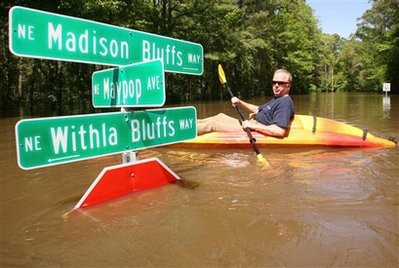
© AP Photo/Tallahassee Democrat, Phil SearsTim McDonald turns onto Withia Bluffs Way in his kayak to head to check on his house Thursday, April 9, 2009 in eastern Madison County, Fla. Initial reports so far show the rising waters have destroyed or caused major damage to nearly 200 homes and minor damage to more than 500 in Florida since the flooding
Tampa - Forecasters reported two tornadoes touched down in the Tampa Bay area as a line of storms Tuesday ripped roof shingles off homes, uprooted trees and forced the evacuation of school children in trailer classrooms on Florida's west coast.
No injuries were immediately reported. It was the latest round of bad weather to hammer the South after heavy rain and strong winds Monday that hit Alabama, Tennessee, Georgia, Kentucky and northern Florida, still reeling from storms and tornados last week.
The National Weather Service issued a tornado watch for 20 Florida counties until Tuesday afternoon.
"To our knowledge, there's been no true structure damage and no injuries," said Jim Martin, Emergency Management Director for Pasco County, where at least one twister was spotted Tuesday morning near Holiday, about 30 miles northwest of Tampa.

Comment: See also: US Military research site shows Arctic ice thickening over last 12 months